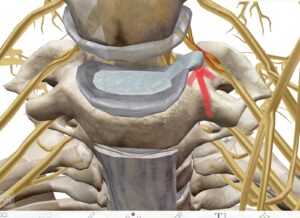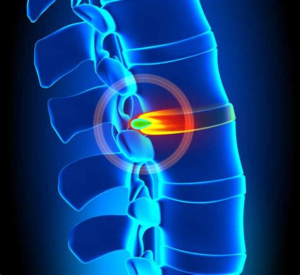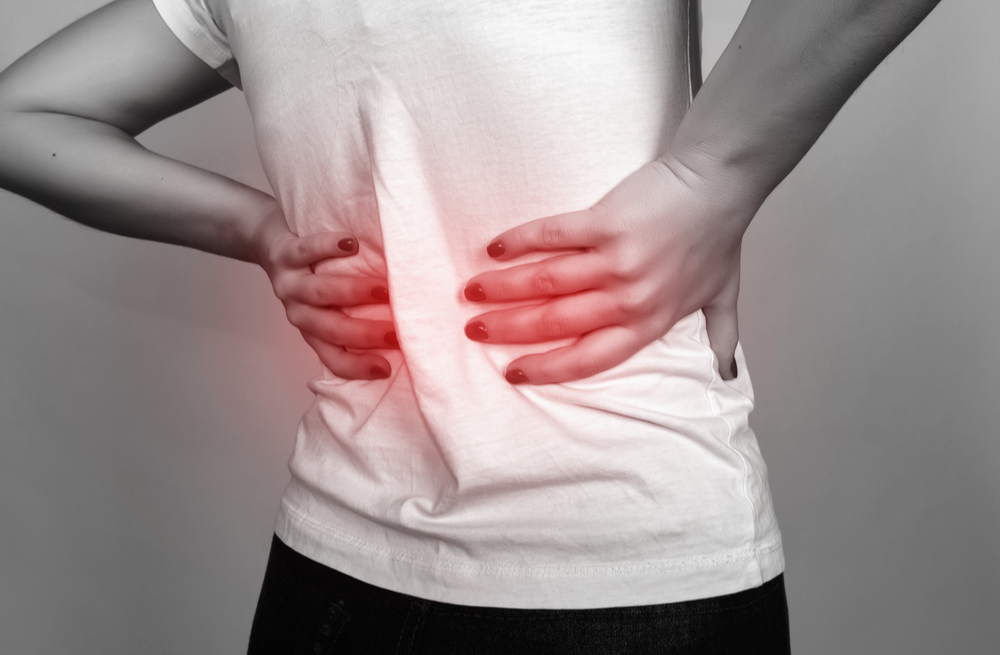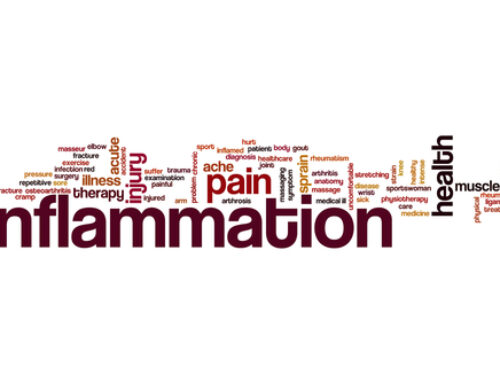We treat numerous types of patients in the office with various extremity and low back issues. Frequently, our patients will tell us they have or had a disc herniation. Most of the time these patients are very concerned with this diagnosis and are looking for an alternative to surgery to help resolve their pain condition.
 A disc herniation is when the discs in between our spinal segments are creating irritation on a nerve root, which can cause pain, loss of function and other neurological symptoms, but not always. When looking at the patients who are more likely to have a disc herniation, we find those that have an occupation or recreational activities with more physical demand to be at a higher risk.
A disc herniation is when the discs in between our spinal segments are creating irritation on a nerve root, which can cause pain, loss of function and other neurological symptoms, but not always. When looking at the patients who are more likely to have a disc herniation, we find those that have an occupation or recreational activities with more physical demand to be at a higher risk.
There are surgical and nonsurgical options as treatment for this common complaint. However, research suggests that surgical intervention may only provide short term relief and decrease the recovery rate. In fact, nearly 70% of symptomatic patients will improve with just a few weeks of conservative care. Yes, surgical procedures are needed at times, but we want to do the best we can conservatively to get you back to doing what you love.
When considering a surgery for a disc herniation we want to look at the whole picture including resolution of the pain and the length of time a patient can return to normal activities after the surgery. This is important in both young athletes and adult workers. A systematic review compared the findings for return to play in elite athletes. There were 799 patients in the operative group who underwent some type of procedure due to a disc herniation and 308 patients in the nonoperative group who underwent physical therapy and nonsteroidal anti-inflammatory medication. Findings showed 83% of the operative group successfully returned to play, as well as 81.5% from the nonoperative group. When comparing return to play rates with no symptoms, the mean time for the operative group was 5.19 months and 4.11 months for the nonoperative group. However, 35% of the reviewed studies reported complications prior to surgical treatment. This study revealed that there is no statistical difference between the return to play rates in both groups. Based on this info, it is safe to say that operative care does not have faster return to play then nonoperative management.
So, how can you conservatively treat a disc herniation? We treat disc herniations in 4 steps; In-office treatment, behavior modification, patient self care, and anti-inflammatory nutritional changes.
1. In-office Treatment
In-office treatment centers on pain relief and postural unloading of the affected disc. As we stated above, research has shown that the vast majority of disc disorders will resolve in 12-16 weeks with good conservative care. In our office, this conservative care involves soft-tissue treatments to reduce tight and painful muscles and chiropractic manipulations to improve the function of the affected joints. This manual medicine strategy of treatment is designed to change the functional movements of the spine, therefore reducing the pressure being placed on the disc.
When disc herniations create severe nerve irritation, acupuncture can be used to reduce the numbness, tingling, and burning pain that is frequently reported. Acupuncture has been used for centuries to reduce severe pain and inflammation. The disc herniation case is a great example of where acupuncture and manual medicine can combine to produce a powerful conservative treatment option for the patient.
2. Behavior Modification
Disc herniations are most often caused by hundreds, if not thousands, of destabilizing movements that over time wear down the structural integrity of the disc. The result is a change of position of the fluid found in the middle of the disc. These destabilizing movements are usually linked to behaviors or activities that we perform on the job site or on the field.
Think of a roofing contractor who bends forward all day long, everyday. They are at a very high risk of having a disc herniation. Behavior modification begins with identifying the activity or activities that create the pressure on the disc and finding strategies to reduce that. It may mean stopping the activity all together, but for the roofing contractor, that would not be an option. Changes in how they bend, the frequency and speed that they bend, and even the number of breaks they have in the day could greatly improve their disc related pain. Identifying these behaviors and putting together a game plan to modify them is a very important part of any treatment program. Make sure your provider is giving you a clear plan of behavior modifications. Disc herniations do not occur just because “you are at that age” or “it is just genetic”. Almost all disc cases are a mechanical problem, created by repetitive behaviors.
3. Self-Care
 Self-care can be simple things like using ice after your workout to home exercises for improving posture and strength. Self-care can be very helpful but sometimes the wrong self-care can cause the problem to become even worse.
Self-care can be simple things like using ice after your workout to home exercises for improving posture and strength. Self-care can be very helpful but sometimes the wrong self-care can cause the problem to become even worse.
Avoid:
- Stretching the painful areas like the hamstrings or shoulder muscles. This often pulls on the nerve and makes the pain worse.
- Using a heating pad. Although this may feel good temporarily, the heating pad brings more fluid and inflammation to the involved area and can perpetuate the problem. Feel free to use a hot tub or shower though.
Try These:
- Use some ice on the spine where it is sore to reduce the swelling and inflammation near the nerve root. Only use real ice in a baggie, do not use a freezer pack.
- Try doing some nerve flossing. These types of exercises are fantastic for nerve conditions as they help to mobilize the nerve through the area of pain without irritating it. Here are some example videos for disc bulges involving the median, ulnar, and femoral nerves:

- Try an inversion table. These inexpensive tables can be great for individuals with a lumbar disc bulge. They can be helpful for cervical disc bulges as well, but not as consistently.
- McKenzie exercises. These short exercises are simple to perform but can have a huge effect on the disc bulge pain. Here are some example videos of McKenzie exercises that can be performed at home and work:
4. Nutritional Changes
Nutritional changes can be an overlooked home run when treating a disc bulge. Reducing inflammatory foods like sugar, processed foods, and gluten should be the key to any anti-inflammatory diet. Increasing dark vegetables, dark fruits, and foods rich in curcumin or turmeric have been shown to be able to reduce pain. You can also supplement with curcumin by itself or with a product where it is combined with CBD oil. Small changes can have a profound effect. Start today with some small changes to reduce your body’s inflammation levels.
If you have any questions about disc bulges and disc related injuries, call or email our Roanoke, Virginia office. We are dedicated at Core to see you live your ultimate life and be healthier than you have ever been.

Daryl C. Rich, D.C.






